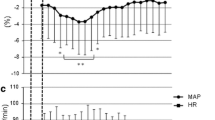Abstract
To investigate the role of cerebral oxygen saturation (ScO2) for prediction of hypotension after spinal anesthesia for caesarean section. Forty-five parturients undergoing elective caesarean section under spinal anesthesia were selected. Blood pressure, heart rate and pulse oxygen saturation before and after anesthesia were recorded, and the association between changes in ScO2 before and after anesthesia with hypotension after spinal anesthesia was explored. Hypotension occurred in 32 parturients after spinal anesthesia. The decrease in ScO2 after spinal anesthesia in parturients with hypotension was larger than in parturients without hypotension (P < 0.05). The duration from the intrathecal injection to 5 % decrease in ScO2 was shorter than that from the intrathecal injection to the occurrence of hypotension (P < 0.05). The mean time from 5 % decrease in ScO2 to hypotension was 38 s. The area under the receiver operation characteristic curve was 0.83 for decrease in ScO2 for prediction of hypotension (P < 0.05), and the optimal threshold value was 4.5 %. The sensitivity, specificity, positive predictive value and negative predictive value of 4.5 % decrease in ScO2 for prediction of hypotension were 0.75, 0.78, 0.92 and 0.47, respectively. The decrease in ScO2 after spinal anesthesia is associated with hypotension after spinal anesthesia for cesarean section, and may be a clinically useful predictor.

Similar content being viewed by others
References
Emmett RS, Cyna AM, Andrew M, Simmons SW. Techniques for preventing hypotension during spinal anaesthesia for caesarean section. Cochrane Database Syst Rev. 2002;3:CD002251.
Mercier FJ, Augè M, Hoffmann C, Fischer C, Le Gouez A. Maternal hypotension during spinal anesthesia for caesarean delivery. Minerva Anestesiol. 2013;79(1):62–73.
McDonald S, Fernando R, Ashpole K, Columb M. Maternal cardiac output changes after crystalloid or colloid coload following spinal anesthesia for elective cesarean delivery: a randomized controlled trial. Anesth Analg. 2011;113(4):803–10.
Beilin Y. The treatment should not be worse than the disease. Anesthesiology. 2006;104(6):1348–9.
Bhardwaj N, Jain K, Arora S, Bharti N. A comparison of three vasopressors for tight control of maternal blood pressure during cesarean section under spinal anesthesia: effect on maternal and fetal outcome. J Anaesthesiol Clin Pharmacol. 2013;29(1):26–31.
Mohta M, Janani SS, Sethi AK, Agarwal D, Tyagi A. Comparison of phenylephrine hydrochloride and mephentermine sulphate for prevention of post spinal hypotension. Anaesthesia. 2010;65(12):1200–5.
Ngan Kee WD, Khaw KS, Ng FF. Prevention of hypotension during spinal anesthesia for cesarean delivery: an effective technique using combination phenylephrine infusion and crystalloid cohydration. Anesthesiology. 2005;103(4):744–50.
Madsen PL, Secher NH. Near-infrared oximetry of the brain. Prog Neurobiol. 1999;58(6):541–60.
Scheeren TW, Schober P, Schwarte LA. Monitoring tissue oxygenation by near infrared spectroscopy (NIRS): background and current applications. J Clin Monit Comput. 2012;26(4):279–87.
Scholkmann F, Klein SD, Gerber U, Wolf M, Wolf U. Cerebral hemodynamic and oxygenation changes induced by inner and heard speech: a study combining functional near-infrared spectroscopy and capnography. J Biomed Opt. 2014;19(1):17002.
Karen T, Wolf M, Nef R, Haensse D, Bucher HU, Schulz G, Fauchère JC. Changes in cerebral oxygenation during early postnatal adaptation in newborns delivered by vacuum extraction measured by near-infrared spectroscopy. BMC Pediatr. 2014;14:21.
Weatherall A, Skowno J, Lansdown A, Lupton T, Garner A. Feasibility of cerebral near-infrared spectroscopy monitoring in the pre-hospital environment. Acta Anaesthesiol Scand. 2012;56(2):172–7.
Colier WN, Binkhorst RA, Hopman MT, Oeseburg B. Cerebral and circulatory haemodynamics before vasovagal syncope induced by orthostatic stress. Clin Physiol. 1997;17(1):83–94.
Ilies C, Kiskalt H, Siedenhans D, Meybohm P, Steinfath M, Bein B, Hanss R. Detection of hypotension during caesarean section with continuous non-invasive arterial pressure device or intermittent oscillometric arterial pressure measurement. Br J Anaesth. 2012;109(3):413–9.
Kitchen CC, Nissen P, Secher NH, Nielsen HB. Preserved frontal lobe oxygenation following calcium chloride for treatment of anesthesia-induced hypotension. Front Physiol. 2014;22(5):407.
Berlac PA, Rasmussen YH. Per-operative cerebral near-infrared spectroscopy (NIRS) predicts maternal hypotension during elective caesarean delivery in spinal anaesthesia. Int J Obstet Anesth. 2005;14(1):26–31.
Hanss R, Bein B, Ledowski T, Lehmkuhl M, Ohnesorge H, Scherkl W, Steinfath M, Scholz J, Tonner PH. Heart rate variability predicts severe hypotension after spinal anesthesia for elective cesarean delivery. Anesthesiology. 2005;102(6):1086–93.
Ngan Kee WD, Lee A, Khaw KS, Ng FF, Karmakar MK, Gin T. A randomized double-blinded comparison of phenylephrine and ephedrine infusion combinations to maintain blood pressure during spinal anesthesia for cesarean delivery: the effects on fetal acid–base status and hemodynamic control. Anesth Analg. 2008;107(4):1295–302.
Parpaglioni R, Frigo MG, Lemma A, Sebastiani M, Barbati G, Celleno D. Minimum local anaesthetic dose (MLAD) of intrathecal levobupivacaine and ropivacaine for Caesarean section. Anaesthesia. 2006;61(2):110–5.
Desalu I, Kushimo OT. Is ephedrine infusion more effective at preventing hypotension than traditional prehydration during spinal anaesthesia for caesarean section in African parturients? Int J Obstet Anesth. 2005;14(4):294–9.
Klöhr S, Roth R, Hofmann T, Rossaint R, Heesen M. Definitions of hypotension after spinal anaesthesia for caesarean section: literature search and application to parturients. Acta Anaesthesiol Scand. 2010;54(8):909–21.
Author information
Authors and Affiliations
Corresponding author
Ethics declarations
Conflict of interest
The authors declare that they have no conflict of interest.
Rights and permissions
About this article
Cite this article
Sun, S., Liu, Nh. & Huang, Sq. Role of cerebral oxygenation for prediction of hypotension after spinal anesthesia for caesarean section. J Clin Monit Comput 30, 417–421 (2016). https://doi.org/10.1007/s10877-015-9733-4
Received:
Accepted:
Published:
Issue Date:
DOI: https://doi.org/10.1007/s10877-015-9733-4




